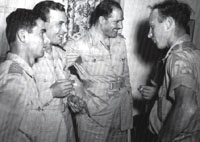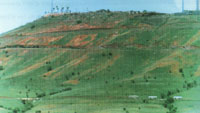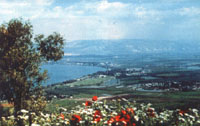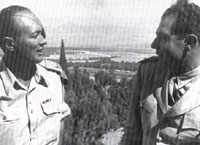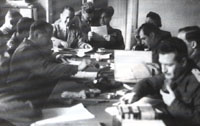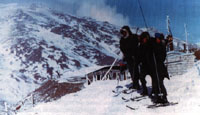http://www.mideastinsight.org/9_99/lineofjune67_9.99.html
THE LINE OF JUNE 4, 1967
By Frederic C. Hof
Aryeh Shalev (right) with Syrian officers at a meeting of the Iraeli-Syrian Mixed Armistice Commission in 1951 The phrase "the line of June 4, 1967" has been part of the Arab-Israeli peace process lexicon for over five years. Although it encapsulates the extent of the withdrawal demanded of Israel by Syria in the context of a peace treaty its meaning has not been defined in published accounts of Israeli-Syrian negotiations. This article seeks to define the line of June 4, 1967 in its historical context. Its diplomatic definition may, depending on the course of Syrian-Israeli negotiations, be something quite different. As for the historical context, however, the definition has two parts: the conceptual meaning of the phrase and the location of the line itself.
Three Lines: Boundary, Armistice Demarcation, and June 4, 1967
Conceptually, the line of June 4, 1967 was the confrontation line between Israel and Syria on the day before the outbreak of the June 1967 war. Only along one 15-kilometer stretch did it correspond with the international boundary between Palestine and Syria instituted by Great Britain and France in 1923. Neither did it correspond to the Armistice Demarcation Line agreed to by the parties in 1949. The line of June 4, 1967 was neither a boundary, nor an armistice line, nor anything demarcated in a way recognizable to an attorney, a diplomat, or a surveyor.
The locations of Israeli and Syrian military units and Jewish and Arab settlements in June 1967 were the results of very recent history. The boundary itself was a product of the post-World War I Anglo-French partition of Ottoman Syria. It had been drawn with water—water for the Jewish Home—very much on the minds of British boundary negotiators. It was demarcated so that all of Lake Tiberias, including a 10-meter wide strip of beach along its northeastern shore, would stay inside Palestine. From Lake Tiberias north to Lake Hula the boundary was drawn between 50 and 400 meters east of the Jordan River, keeping that stream entirely within Palestine. Palestine also received a sliver of land along the Yarmouk River, the Jordan’s largest tributary, out to the town of al-Hamma—today’s Hamat-Gader.
This 1923 boundary was not, however, drawn to facilitate the military defense of northeastern Palestine. The task of successfully defending the boundary against virtually any sort of enemy presented insurmountable problems. Short of establishing positions inside Syria, how could one secure a 10-meter strip of beach, or a thin salient along the Yarmouk, or a narrow strip of Palestine east of the Jordan River, all of which were on ground lying well below the Golan Heights? The Great War allies who accomplished the demarcation surely did not anticipate that their respective clients would be at war within 25 years.
Golan Heights in 1993 Yet go to war they did, in May 1948. During the initial two months of fighting Syrian forces advanced in several places across the 1923 boundary, most significantly across the Jordan River where they took the Jewish settlement of Mishmar Ha-Yarden. Although Syrian attacks south of Lake Tiberias were repelled, the 10-meter strip of beach and the east bank of the Jordan were theirs by default, as were Palestinian Arab villages east of the lake, such as al-Hamma and Khirbet al-Tawafiq. Syrian forces also established a foothold in the extreme northeastern corner of Palestine, just east of the Jewish settlement of Dan.
During armistice talks under UN auspices in the spring and summer of 1949, Israel sought the removal of all Syrian forces from Palestine/ Israel. Syria demurred, insisting on an armistice line based not on an international border, which Syria insisted did not exist, but on the military status quo. The result was a compromise. Under the terms of an armistice signed on July 20, 1949, Syrian forces were to withdraw east of the old Palestine-Syria boundary. Israeli forces were to refrain from entering the evacuated areas, which would become a demilitarized zone, "from which the armed forces of both Parties shall be totally excluded, and in which no activities by military or paramilitary forces shall be permitted."
In essence, therefore, major parts of the armistice line departed from the 1923 boundary and protruded into Palestine/ Israel. There were three distinct, non-contiguous enclaves within Palestine/ Israel—in the extreme northeast between Banias and Dan, on the west bank of the Jordan River near Lake Hula, and the eastern-southeastern shores of Lake Tiberias extending out to al-Hamma—consisting of 66.5 square kilometers of land lying between the 1949 armistice line and the 1923 boundary. These were the three sectors—north, central and south—of the demilitarized zone. The 1923 boundary prevailed as the armistice line in only two places: where it connected the northern and central sectors of the demilitarized zone; and along the 10-meter strip of Lake Tiberias, connecting the central and southern sectors of the demilitarized zone.
From 1949 Armistice to June 4, 1967
The 1923 boundary was demarcated so that all of Lake Tiberias would stay within Palestine. Major elements of the line of June 4, 1967 were set in place by war in 1948, armistice in 1949 and, above all, by the failure of the Parties to convert their armistice to a treaty of peace in the early 1950s. As it became increasingly clear that peace was not on the horizon, Israel and Syria both sought to take maximum advantage of the territorial ambiguities left in place by their armistice. This advantage-taking left the armistice itself in a shambles and resulted in an evolving tactical situation, one "snapshot" of which, frozen in time, was the disposition of forces on June 4, 1967.
In 1966 an exasperated UN secretary-general reported that Israel and Syria together had produced some 66,000 official complaints about the conduct of the other, the vast majority of which pertained to alleged violations in the demilitarized zone. There were numerous Israeli complaints of infiltration, murder, mayhem, and shelling from the Syrian side of the armistice demarcation line. Those Israeli complaints not centering on the demilitarized zone often focused on Syria’s de facto annexation of the 10-meter strip and direct access to Lake Tiberias, behavior explicitly criticized by the Israel-Syria Mixed Armistice Commission (ISMAC) of the UN Truce Supervision Organization (UNTSO). Syrian complaints most often centered on a theme which Israel was pleased to acknowledge: that Israel acted as if the demilitarized zone were part of Israel-proper.
(l.-r.) Israeli General Dayan and Syrian Lieutenant Colonel Jadid on the balcony of Hotel Shulamit in Rosh Pina: According to Dayan, more than 80 percent of border incidents resulted from Israeli provocation involving aggressive agricultural activities in territory claimed by the Jewish state. To catalogue, recount and assess blame for the thousands of violent incidents occurring on the Syria-Israel frontier from 1949 until June 5,1967 is far beyond the scope of this essay. It will suffice to make several points with which both parties would probably agree.
1. Israel claimed the demilitarized zone as sovereign Israeli territory in which Israel had only "consented to the demilitarization of the areas from which the Syrian army had retreated." Syria, on the other hand, asserted no sovereign claim to land in what had been Palestine. Instead it considered the demilitarized zone essentially as a buffer zone subject to UN supervision, the sovereign definition of which had been deferred indefinitely by the armistice.
2. Starting in the spring of 1951 Israel began to assert its sovereign claim quite actively, using the drainage and reclamation of the Hula swamp—located adjacent to the central sector of the demilitarized zone—to test Syria’s response. Syria opposed the project on the grounds that it would alter military geography in the demilitarized zone to Israel’s advantage and do substantial harm to Palestinian Arab farmers. According to Aryeh Shalev, "The central [Israeli] idea seems to have been to engage in a policy of brinkmanship—forcing Syria either not to interfere or face the risk of military deterioration which could escalate into war—combined with an attempt to strengthen Israeli control in the DZ." In March and April 1951 there was a series of armed clashes when Israeli tractors crossed to the east bank of the Jordan River, which "was under the complete control of the Syrians, as it had been even prior to the signing of the armistice agreement." and when Israeli soldiers, disguised as policemen, attempted—unsuccessfully—to "show the flag" in al-Hamma.
3. The upshot of armed clashes in the spring of 1951 was the informal partition of the demilitarized zone. Israel expelled Arab villagers from the central sector and asserted control of that sector up to the Jordan River. Syria exercised effective control over the east bank portion of the central sector—from Lake Hula to Lake Tiberias—took the dominating high ground—Tel al-Azaziat—in the northern sector and, according to Shalev, "seized areas close to its border—al-Hamma, [K]hirbet al-Tawafiq, al-Nuqeib, [and] the northeastern shore of Tiberias . . ." Although there would be alterations to this partition over the next 16 years—all minor and all at Syria’s expense—the events of 1951 would essentially define the line of June 4, 1967.
4. In 1952 and 1953 Israel and Syria held secret military talks to explore the possibility of formalizing the partition of the demilitarized zone. Although the talks achieved consensus on some major points: a new boundary along the east bank of the Jordan, keeping the river within Israel, partition of the northern sector and southern sectors of the demilitarized zone, and reduction of the 10-meter strip to one meter, keeping Lake Tiberias within Israel, they failed. Syria essentially wanted a new armistice line in order to halt more creeping Israeli annexation of the demilitarized zone, but was not interested in conveying formal recognition to Israel. To the extent that Israel might have been tempted to abandon the 1923 boundary, it might have done so in exchange for a treaty of peace—nothing less. Even in the context of a peace treaty, according to Professor Moshe Brawer, a Syrian presence on the water line of the Jordan and Tiberias "would only have been possible if they gave up any riparian rights to the river and lake."
5. From 1953 until June 1967 Israel’s struggle to assert its sovereignty all the way to the 1923 boundary became a game of inches, punctuated by serious armed clashes. In words attributed to the late Moshe Dayan, "more than 80 percent" of the incidents resulted from Israeli provocation involving aggressive agricultural activities, albeit in territory claimed by Israel. Regardless of their genesis, these incidents often involved Syrian shelling into the demilitarized zone by artillery batteries high above their targets, followed by Israeli attacks on Syrian positions, sometimes within Syria. These incidents, combined with an escalating war of words between Syria and Israel and a general breakdown in Arab-Israeli relations, led to war in June 1967. By June 10, 1967 the line of June 4, 1967 was well to the rear of Israeli forces.
The Line of June 4, 1967 and Its Implications for a Settlement
The Israeli-Syrian Mixed Armistice Commission with the Israelis seated on the left and the Syrians on the right: Israel and Syria together had produced some 66,000 official complaints about each other's conduct. In an interview with the author, the Syrian ambassador to the United States, Walid al-Moualem, stated that Syria has never recognized the 1923 international boundary, that it will indeed make a claim to lands west of that boundary, and that its claim will be consistent with the line of June 4, 1967. He declined, however, to be specific, asserting only that Syria and the UN possess identical maps of the status of Syrian and Israeli forces just before the outbreak of war in June 1967. He did, however, say that: "Sometimes people equate the line of June 4 with the town of al-Hamma. It is true that this is a place held dear by the Syrian people, and I myself have camped there as a Boy Scout. But the line of June 4 is more than al-Hamma. It involves water issues for which I believe fair and equitable solutions can be found."
Water concerns would arise because a drawing of a line representing the status quo of June 4, 1967 would place Syria on the northeastern shore of Lake Tiberias and along the east bank of the Jordan River between Lake Tiberias and the former Lake Hula. According to Professor Brawer, the foremost Israeli expert on the geographical aspects of this matter, Syria held some 18 of the 66.5 kilometers of the demilitarized zone on the eve of war in June 1967.
In a letter to the author dated June 12,1999, Professor Brawer outlined his understanding of key points along the line of June 4, 1967 as follows: the northern sector of the demilitarized zone was "dominated" by the Syrian position at Tel al-Azaziat, with Israel controlling about one-third of the sector by means of cultivation; "From a short distance south of the former Lake Hula to a short distance north of Lake Kinneret [Tiberias] the River Jordan was in fact the dividing line between Israeli and Syrian held territories; …As to the small demilitarized zone west of the Jordan River, just above its entrance into Lake Kinneret, I assume that the Syrians actually controlled a small part on the eastern fringes of that zone: …The Syrians fully controlled the northeastern shore of Lake Kinneret and the adjacent waters of the lake;" within the southern sector of the demilitarized zone Syria controlled small parcels of land "north of the former village [of] al-Nuqeib, a small area near the village [of] Kafr Hareb and an area west of Upper Khirbet al-Tawafiq" as well as al-Hamma and the entire Yarmouk salient, "up to about three kilometers of the Israeli village [of] Shaar Hagolan."
A boundary settlement exactly reflecting the line of June 4, 1967 would raise, within Israel, water-related concerns first surfaced by Zionist leaders and their British allies during and immediately after the first World War. It may fairly be asked, however, whether the addition of perhaps 20 square kilometers to the Syria of 1923-1948 would raise hydrological issues far transcending those implicit in a settlement based on the 1923 boundary itself. In both cases Israel will be concerned with Syrian water management practices on the Golan Heights. In both cases Israel will want assurances concerning Syrian control of the Banias Spring. In both cases—unless Syrian citizens can be kept a tantalizing 10 meters away from Lake Tiberias and 50 meters away from the Jordan River—there would appear to be an issue of Syrian access to and use of water from those bodies.
The sine qua non of any Israeli-Syrian settlement rests on mutually acceptable military security provisions. Security assurances that would permit Israel to return the Golan Heights and retire to the 1923 boundary would surely apply with equal effect to an additional 20 square kilometers. If the problem comes down to water, the solution, under either boundary scenario, might involve—as it did during the Mandate period and during the secret talks of 1952-1953—Israeli ownership of the water combined with access and use provisions for Syrian nationals.
Another approach to the issue might involve the following formulation: withdrawal to the line of June 4 by Israel without advance to the line of June 4 by Syria. Under this scenario Syria might receive al-Hamma, and the new boundary would keep the Banias Spring inside Israel and maintain plenty of space between Syria and the Jordan Valley, including Lake Tiberias. Yet the Israeli side of the new boundary would be completely demilitarized, thus fulfilling the Syrian demand for total Israeli withdrawal from lands occupied in June 1967.
If, in the 50th anniversary year of their armistice, Syria and Israel are prepared to reach the "ultimate territorial arrangement" anticipated by the document, there is nothing about the line of June 4, 1967 per se that would obstruct matters. This essay has sought to define the line in historical and geographical terms. It is up to Israel and Syria to determine its political meaning and, assuming agreement in principle, draw a line on the ground.
Frederic Hof, a partner in Armitage Associates L.C., left government in 1993 as a member of the Senior Executive Service of the United States. Mr. Hof has written extensively on Lebanon and the Israel-Syria track of the peace process ands is the author of Galilee Divided: the Israel-Lebanon Frontier 1916-1984. This article is based on a longer monograph to be published this fall by Middle East Insight.
FOOTNOTES
UNDOF observers on Mount Hermon in December 1976. 1. A comprehensive statement of Syria’s position may be found in an interview of Syria’s ambassador to the United States, Walid al-Moualem, conducted by Linda Butler, Managing Editor of the Journal of Palestine Studies in the Winter 1997 (Issue 102) edition.
2. See Itamar Rabinovich, The Brink of Peace: the Israeli-Syrian Negotiations (Princeton: Princeton University Press, 1998) and Uri Savir, The Process (New York, Random House, 1998).
3. According to Ambassador al-Moualem, use of the date June 4—as opposed to June 9, the date of Israel’s assault on the Golan Heights—is explained by Syria’s reliance on UN Security Council Resolution 242 as the legal basis for its position on the extent of Israeli withdrawal. The resolution calls for "Withdrawal of Israeli armed forces from territories occupied in the recent conflict." The June 1967 war began on the Egyptian front on June 5.
4. A complete text of the Israel-Syria General Armistice Agreement appears in N. Bar-Yaacov, The Israel-Syrian Armistice (Jerusalem, Magnes Press, 1967), Appendix I.
5. Security Council Official Records, Document S/7572, p. 62.
6. Security Council Official Records, Document S/3343, p. 12.
7. Ibid., p. 22.
8. Aryeh Shalev, The Israel Syria Armistice Regime, 1949-1955 (Tel Aviv, Jaffee Center for Strategic Studies, 1993), p. 57.
9. Ibid., pp. 83-84.
10. Ibid., p. 77.
11. Ibid., pp. 135-152.
12. Letter to the author dated July, 6 1999.
13. Rami Tal, "Moshe Dayan: Introspection," Yedi’ot Aharonot, April, 27 1997. FBIS Document Number FBIS-NES-97, April, 27 1997.
14. Aluf Ben and Akiva Eldar, "Syrian Demand for Withdrawal to Armistice Line Reviewed," Ha’aretz, May, 29 1995, pp. A1-A2, FBIS Document Number FBIS-NES-9-104.
15. In addition to the letter cited above, Professor Brawer provided the author a map on which he sketched his understanding of areas west of the international boundary controlled by Syria on the eve of war in June 1967. Information provided by Professor Brawer and by Aryeh Shalev—with whom the other corresponded—together with UN documentation form the basis of the cartographic depiction of the line of June 4, 1967 found in this study.
MAPS


"When a Jew, in America or in South Africa, talks to his Jewish companions about 'our' government, he means the government of Israel."
- David Ben-Gurion, Israeli Prime Minister
Viva Palestina!
Latest Additions - in English
What is this Jewish carnage really about? - The background to atrocities
Videos on Farrakhan, the Nation of Islam and Blacks and Jews

How Jewish Films and Television Promotes bias Against Muslims
Judaism is Nobody's Friend
Judaism is the Jews' strategy to dominate non-Jews.Islam and Revolution
By Ahmed RamiHasbara - The Jewish manual for media deceptions
Celebrities bowing to their Jewish masters
Elie Wiesel - A Prominent False Witness
By Robert Faurisson
Iraq - war and occupation
CNN's Jewish version of "diversity" - Lists the main Jewish agents
Hezbollah the Beautiful
Americans, where is your own Hezbollah?Black Muslim leader Louis Farrakhan's Epic Speech in Madison Square Garden, New York
- A must see!
"War on Terror" - on Israel's behalf!
World Jewish Congress: Billionaires, Oligarchs, Global Influencers for Israel
Interview with anti-Zionist veteran Ahmed Rami of Radio Islam - On ISIS, "Neo-Nazis", Syria, Judaism, Islam, Russia...
Britain under Jewish occupation!

Jewish World Power
West Europe East Europe
Americas Asia
Middle East Africa
U.N. E.U.The Internet and Israeli-Jewish infiltration/manipulations
Books - Important collection of titles
Israel: Jewish Supremacy in Action - By David Duke
Jew Goldstone appointed by UN to investigate War Crimes in Gaza
The Israel Lobby - From the bookJews and Crime - The archive
Sayanim - Israel's and Mossad's Jewish helpers abroad
Listen to Louis Farrakhan's Speech - A must hear!
"Jewish History" - a bookreview
Israel's attack on US warship USS Liberty - Massacre in the Mediterranean
Jewish "Religion" - What is it?
Medias in the hands of racists
Israel controls U.S. Presidents
Biden, Trump, Obama, Bush, Clinton...The Victories of Revisionism
By Professor Robert Faurisson
The Jewish hand behind Internet The Jews behind Google, Facebook, Wikipedia, Yahoo!, MySpace, eBay...
"Jews, who want to be decent human beings, have to renounce being Jewish"
Jewish Manipulation of World Leaders
Al Jazeera English under Jewish infiltration
Garaudy's "The Founding Myths
of Israeli Politics"
Jewish hate against Christians
By Prof. Israel ShahakIntroduction to Revisionist
Thought - By Ernst ZündelKarl Marx: The Jewish Question
Reel Bad Arabs - Revealing the racist Jewish Hollywood propaganda
Videos
- Important collection
The Jews Banished 47 Times in 1000 Years - Why?
Zionist strategies - Plotting invasions, formenting civil wars, interreligious strife, stoking racial hatreds and race war
The International Jew
By Henry Ford
Pravda interviews Ahmed Rami
Shahak's "Jewish History,
Jewish Religion"
The Jewish plan to destroy the Arab countries - From the World Zionist OrganizationJudaism and Zionism inseparable
Horrors of ISIS Created by Zionist Supremacy - By David Duke
The Freedom Fighters:
Hezbollah - Lebanon
Nation of Islam - U.S.A.
Jewish Influence in America

- Government, Media, Finance..."Jews" from Khazaria stealing the land of Palestine
The U.S. cost of supporting Israel
Israel and the Ongoing Holocaust in CongoJews DO control the media - a Jew brags! - Revealing Jewish article
Protocols of Zion - The whole book!
Encyclopedia of the
Palestine Problem
The "Holocaust" - 120 Questions and AnswersQuotes - On Jewish Power / Zionism
Activism! - Join the Fight!
|
Races? Only one Human race United We Stand, Divided We Fall |
 |
No time to waste. Act now! Tomorrow it will be too late |
|

























